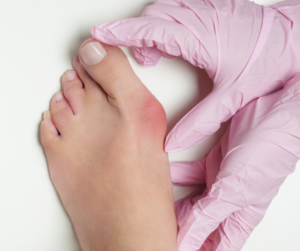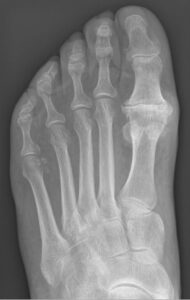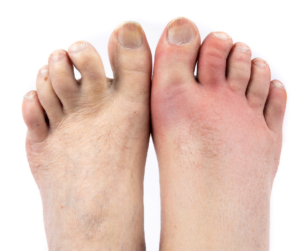When Your “Bunion” is Really Something Else
One of the most common patient concerns we encounter at Tri-State Foot and Ankle Center is a “painful bunion”. I place this in quotes because many patients assume they have a bunion, when indeed they don’t!
Bunions

Bunions occur when the great toe, or “hallux” leans towards the 2nd toe and when the joint behind the great toe (the first MPJ) becomes pronounced in the opposite direction. As this “widens” the forefoot, patients experience pain at the side of the joint, where it rubs against their shoe. Additionally, pressure between the great toe and 2nd toe can also cause blisters or corns (skin which thickens and hardens as a results of friction and prolonged pressure). Bunions, while aggravated and exacerbated by the use of stiff, tight, or pointed shoes, are not caused by shoes, but rather are hereditary in nature.
Hallux Rigidus
 An alternate cause of 1st MPJ pain is Arthritis at the joint. Bunion deformities can progress to the point of additionally causing arthritis, yet one may simply have arthritis at the first metatarsal-phalangeal joint and not a bunion. First MPJ arthritis, or Hallux Rigidus, can cause bone spurs to form around the joint causing an obvious “bump” at the top or sides of the joint. This arthritis is commonly a result of either past injury to the joint or a reduction of normal joint range of motion, due to foot or ankle biomechanical issues. As with bunions, the joint can appear or feel enlarged and swollen, which can be painful, both in a shoe or during range of motion of the great toe, (for example hyperflexion while going up stairs, standing on one’s tip-toes, or squatting with the heel raised). A lack of proper joint function ultimately causes chronic inflammation, cartilage wear, and bone spur development, which can then further restrict range of motion and cause a stiff joint.
An alternate cause of 1st MPJ pain is Arthritis at the joint. Bunion deformities can progress to the point of additionally causing arthritis, yet one may simply have arthritis at the first metatarsal-phalangeal joint and not a bunion. First MPJ arthritis, or Hallux Rigidus, can cause bone spurs to form around the joint causing an obvious “bump” at the top or sides of the joint. This arthritis is commonly a result of either past injury to the joint or a reduction of normal joint range of motion, due to foot or ankle biomechanical issues. As with bunions, the joint can appear or feel enlarged and swollen, which can be painful, both in a shoe or during range of motion of the great toe, (for example hyperflexion while going up stairs, standing on one’s tip-toes, or squatting with the heel raised). A lack of proper joint function ultimately causes chronic inflammation, cartilage wear, and bone spur development, which can then further restrict range of motion and cause a stiff joint.
Gout

Lastly, an acutely painful first metatarsal phalangeal joint without recent trauma may be the result of a Gout attack. Gout occurs most commonly in middle-aged men and is caused by monosodium urate (MSU) crystal deposition in joints and soft tissues as a result of a condition known as hyperuricemia, or elevated levels of uric acid in the blood. A gouty attack at the 1st mpj is termed “Podagra”. Symptoms of gout include redness, swelling, and intense pain of the joint which, if left untreated, can last for two to three weeks before resolving on its own. Repeated gouty attacks can lead to progressive joint damage and ultimately gouty arthritis. If gout is suspected, the condition at large should be discussed with a physician, as hyperuricemia can be caused by genetics, insulin resistance, iron overload, hypertension, hypothyroidism, chronic kidney disease, obesity, diet, use of diuretics, and the consumption of excess alcoholic beverages.
The treatment plan for each of the above first mpj conditions is specific, both in the acute and chronic phases, so let the doctors at Tri-State Foot and Ankle Center assist you with a proper diagnosis and treatment plan from the start!
Call either (302) 475-1299 (Naamans Road Office) or (302) 239-1625 (Hockessin Office) for your evaluation.
For information about us and directions to our offices, you can learn more by visiting our About Page or Locations Page!
We look forward to having you!
